Themed collection C-H Functionalization

Ruthenium-catalyzed direct oxidative alkenylation of arenes through twofold C–H bond functionalization
Significant progress has been accomplished in direct olefinations through twofold C–H bond functionalization of arenes and heteroarenes employing readily accessible, selective and inexpensive ruthenium(II) catalysts.

Chem. Sci., 2013,4, 886-896
https://doi.org/10.1039/C2SC21524A
Catalytic enantioselective carbon-carbon bond formation using cycloisomerization reactions
We present a review highlighting advancements in the field of asymmetric cycloisomerization reactions which, due to significant improvements occurring in the last twenty years, efficiently produce diverse polycyclic compounds with excellent selectivity.
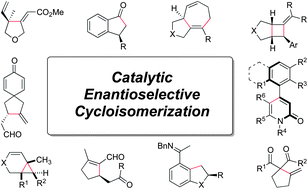
Chem. Sci., 2012,3, 2899-2919
https://doi.org/10.1039/C2SC20542D
Oxidative C–H amination reactions
Towards “Oxidative-Ullmann–Goldberg” and “Oxidative-Buchwald–Hartwig” type amination reactions.
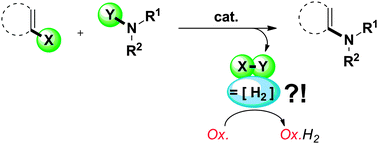
Chem. Soc. Rev., 2014,43, 901-910
https://doi.org/10.1039/C3CS60318K
sp2 C–H bond activation in water and catalytic cross-coupling reactions
This review gathers metal-catalysed sp2 C–H bond activation reactions in water for C–C bond cross-couplings and shows the partnership of water to increase the catalyst activity.
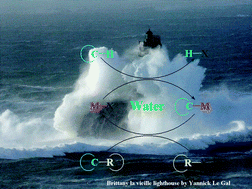
Chem. Soc. Rev., 2013,42, 5744-5767
https://doi.org/10.1039/C3CS60020C
Methane as raw material in synthetic chemistry: the final frontier
The activation and catalytic functionalization of methane are reviewed showing that this area requires further and urgent development in the incoming years.
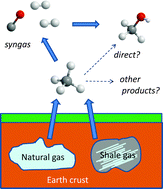
Chem. Soc. Rev., 2013,42, 8809-8820
https://doi.org/10.1039/C3CS60120J
Cyclometalative C–H bond activation in rare earth and actinide metal complexes
Ligand cyclometalative C–H bond activation in rare earth and actinide complexes is discussed. The scope is intended to outline routine cases, while also highlighting exceptional cyclometalation reactions that lead to unusual bonding modes.
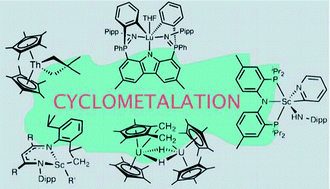
Chem. Soc. Rev., 2013,42, 1947-1960
https://doi.org/10.1039/C2CS35356C
From C(sp2)–H to C(sp3)–H: systematic studies on transition metal-catalyzed oxidative C–C formation
Our recent developments in transition metal-catalyzed oxidative coupling via C–H functionalization of aromatic, benzylic and allylic C–H bonds is summarized.

Chem. Soc. Rev., 2012,41, 5588-5598
https://doi.org/10.1039/C2CS35096C
A walk around the A3-coupling
This tutorial review aims to highlight the current achievements in the field of A3-couplings and related transformations.
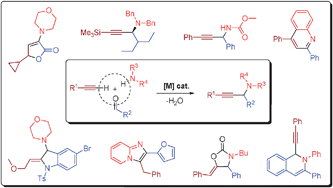
Chem. Soc. Rev., 2012,41, 3790-3807
https://doi.org/10.1039/C2CS15356D
Progress in palladium -based catalytic systems for the sustainable synthesis of annulated heterocycles: a focus on indole backbones
Ligand chemistry has given a significant impetus to produce functionalized indoles by assisting novel powerful palladium-catalysed intra- and intermolecular cyclizations.
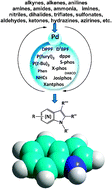
Chem. Soc. Rev., 2012,41, 3929-3968
https://doi.org/10.1039/C2CS15350E
C–C, C–O and C–N bond formation via rhodium(III)-catalyzed oxidative C–H activation
Rh(III) catalysts readily catalyze the oxidative C–H activation of arenes under chelation assistance, leading to C–C, C–N, and C–O bond formation.
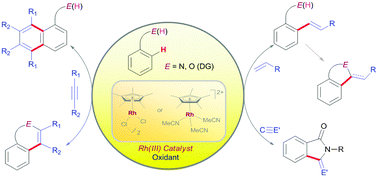
Chem. Soc. Rev., 2012,41, 3651-3678
https://doi.org/10.1039/C2CS15281A
Recent advances in transition metal-catalyzed sp3 C–H amination adjacent to double bonds and carbonyl groups
C–H amination has become a viable method for the efficient installation of nitrogen atoms en route to allyl amines and α-amino carbonyl compounds.
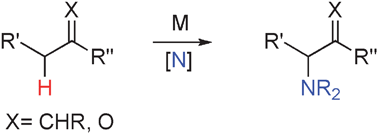
Chem. Soc. Rev., 2012,41, 931-942
https://doi.org/10.1039/C1CS15104E
A room temperature decarboxylation/C–H functionalization cascade by visible-light photoredox catalysis
A room temperature decarboxylation/C–H functionalization cascade has been developed for concise construction of quaternary oxindoles by means of visible-light photoredox catalysis.

Chem. Commun., 2013,49, 5672-5674
https://doi.org/10.1039/C3CC42672F
Pd(II)-catalyzed decarboxylative acylation of phenylacetamides with α-oxocarboxylic acids via C–H bond activation
A palladium-catalyzed decarboxylative acylation of phenylacetamides with α-oxocarboxylic acids via C–H bond activation is described.

Chem. Commun., 2013,49, 1654-1656
https://doi.org/10.1039/C3CC38764J
Pd-catalyzed double C–H bond activation of diaryl ketones for the synthesis of fluorenones
An efficient synthesis of fluorenones from diaryl ketones by Pd-catalyzed oxidative cyclization is described. A possible mechanism involving a carbonyl group assisted ortho-C–H activation and cyclometalation followed by a second C–H activation to form a six-membered palladacycle and reductive elimination is proposed.

Chem. Commun., 2012,48, 9379-9381
https://doi.org/10.1039/C2CC34344D
I2 promoted domino oxidative cyclization for one-pot synthesis of 2-acylbenzothiazoles via metal-free sp3 C–H functionalization
An I2 promoted iodination, Kornblum oxidation, and annulation domino protocol was developed to construct 2-acylbenzothiazoles from aromatic ketones and o-aminobenzenethiols.

Chem. Commun., 2012,48, 9086-9088
https://doi.org/10.1039/C2CC34561G
Palladium -catalyzed direct arylation of benzoxazoles with unactivated simple arenes
Using CuBr2 as an additive, the Pd-catalyzed intermolecular C–H–C–H cross-coupling between benzoxazoles and unactivated simple arenes has been developed.

Chem. Commun., 2012,48, 8964-8966
https://doi.org/10.1039/C2CC34238C
Catalytic oxidation /C–H functionalization of N-arylpropiolamides by means of gold carbenoids: concise route to 3-acyloxindoles
A one-step efficient synthesis of 3-acyloxindole derivatives was developed with extremely good substrate scope and significant opportunities for structural diversification.
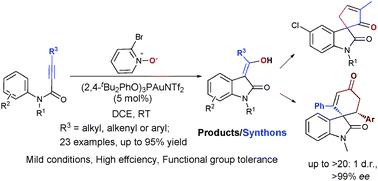
Chem. Commun., 2012,48, 7082-7084
https://doi.org/10.1039/C2CC31972A
Unprecedented synthesis of iron–NHC complexes by C–H activation of imidazolium salts. Mild catalysts for reduction of sulfoxides
A direct synthesis of iron–NHC complexes by C–H activation of the corresponding imidazolium salts with commercially available Fe3(CO)12.
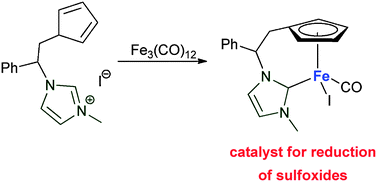
Chem. Commun., 2012,48, 4944-4946
https://doi.org/10.1039/C2CC31564E
Cobalt-catalyzed arylation of aldimines via directed C–H bond functionalization: addition of 2-arylpyridines and self-coupling of aromatic aldimines
A cobalt–N-heterocyclic carbene catalyst promotes a chelation-assisted aromatic C–H functionalization reaction via addition to an aromatic aldimine.
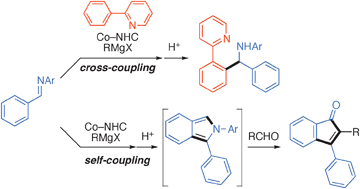
Chem. Commun., 2012,48, 4305-4307
https://doi.org/10.1039/C2CC31114C
Palladium -catalyzed deamidative arylation of azoles with arylamides through a tandem decarbonylation–C–H functionalization
A highly chemo-, regio-selective, and efficient palladium-catalyzed deamidative arylation of azoles with arylamides was developed via a tandem decarbonylation–C–H activation.

Chem. Commun., 2012,48, 4214-4216
https://doi.org/10.1039/C2CC18156H
Fe-catalysed oxidative C–H functionalization/C–S bond formation
Iron served as the catalyst for the direct C–H functionalization/C–S bond formation to afford benzothiazoles under mild conditions.
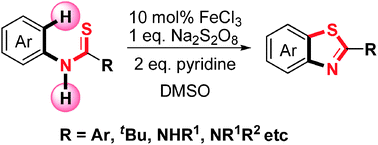
Chem. Commun., 2012,48, 76-78
https://doi.org/10.1039/C1CC16184A
Organocatalytic C–H hydroxylation with Oxone® enabled by an aqueous fluoroalcohol solvent system
Selective hydroxylation of 3° and benzylic C–H bonds is made possible using a non-metal-based catalyst system, Oxone as the terminal oxidant, and an aqueous fluoroalcohol solvent mixture.
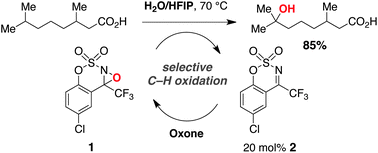
Chem. Sci., 2014,5, 656-659
https://doi.org/10.1039/C3SC52649F
Rh(III)-catalyzed C–H activation–desymmetrization of diazabicycles with arenes: facile synthesis of functionalized cyclopentenes
A Rh(III)-catalyzed C–H activation–desymmetrization of diazabicycles with arenes as an expedient approach to functionalized cyclopentenes is reported.

Chem. Sci., 2014,5, 297-302
https://doi.org/10.1039/C3SC52524D
Rh(III)-catalyzed C–H activation/cycloaddition of benzamides and methylenecyclopropanes: divergence in ring formation
An unprecedented Rh(III)-catalyzed cyclization of benzamides and methylenecyclopropanes for the divergent synthesis of privileged heterocycles is reported.

Chem. Sci., 2013,4, 3421-3426
https://doi.org/10.1039/C3SC51424B
Iridium(III)-bis(oxazolinyl)phenyl catalysts for enantioselective C–H functionalization
A family of iridium(III)-bis(oxazolinyl)phenyl complexes has been developed to catalyze enantioselective C-H functionalization reactions. DFT studies provide evidence for an axially bound carbene and provide a unique model for stereoinduction in atom transfer reactions employing bis(oxazolinyl)phenyl ligands.
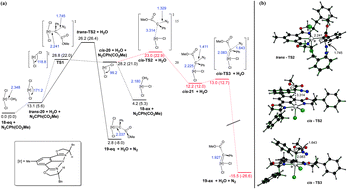
Chem. Sci., 2013,4, 2590-2596
https://doi.org/10.1039/C3SC50886B
A metal–amide dependent, catalytic C–H functionalisation of triphenylphosphonium methylide
We report the [Y{N(SiMe3)2}3] catalysed dehydrocoupling of triphenylphosphonium methylide with phenylsilane to form the silylated ylide Ph3PCHSiH2Ph.

Chem. Sci., 2013,4, 691-695
https://doi.org/10.1039/C2SC21123H
Visible-light-mediated photochemistry: accelerating Ru(bpy)32+-catalyzed reactions in continuous flow
The first application of visible-light-mediated synthetic photochemistry in continuous flow is described. Using an operationally simple photoreactor design, several Ru(bpy)32+-catalyzed transformations were performed with 10–50 fold rate enhancement over the corresponding batch methods.

Chem. Sci., 2012,3, 1612-1616
https://doi.org/10.1039/C2SC01016J
Palladium(0)-catalyzed cyclopropane C–H bond functionalization: synthesis of quinoline and tetrahydroquinoline derivatives
Quinolines and tetrahydroquinolines were prepared from a common precursor through Pd(0)-catalyzed cyclopropane C–H bond functionalization.

Chem. Sci., 2012,3, 244-248
https://doi.org/10.1039/C1SC00458A
About this collection
This collection showcases some of the most cited research papers and reviews published in ChemSocRev, Chemical Science and ChemComm in the area of C-H functionalization.
The collection will be free to access* from the 10th March - 4th April 2014.
*Free access to individuals is provided through an RSC Publishing personal account. Registration is quick, free and simple.